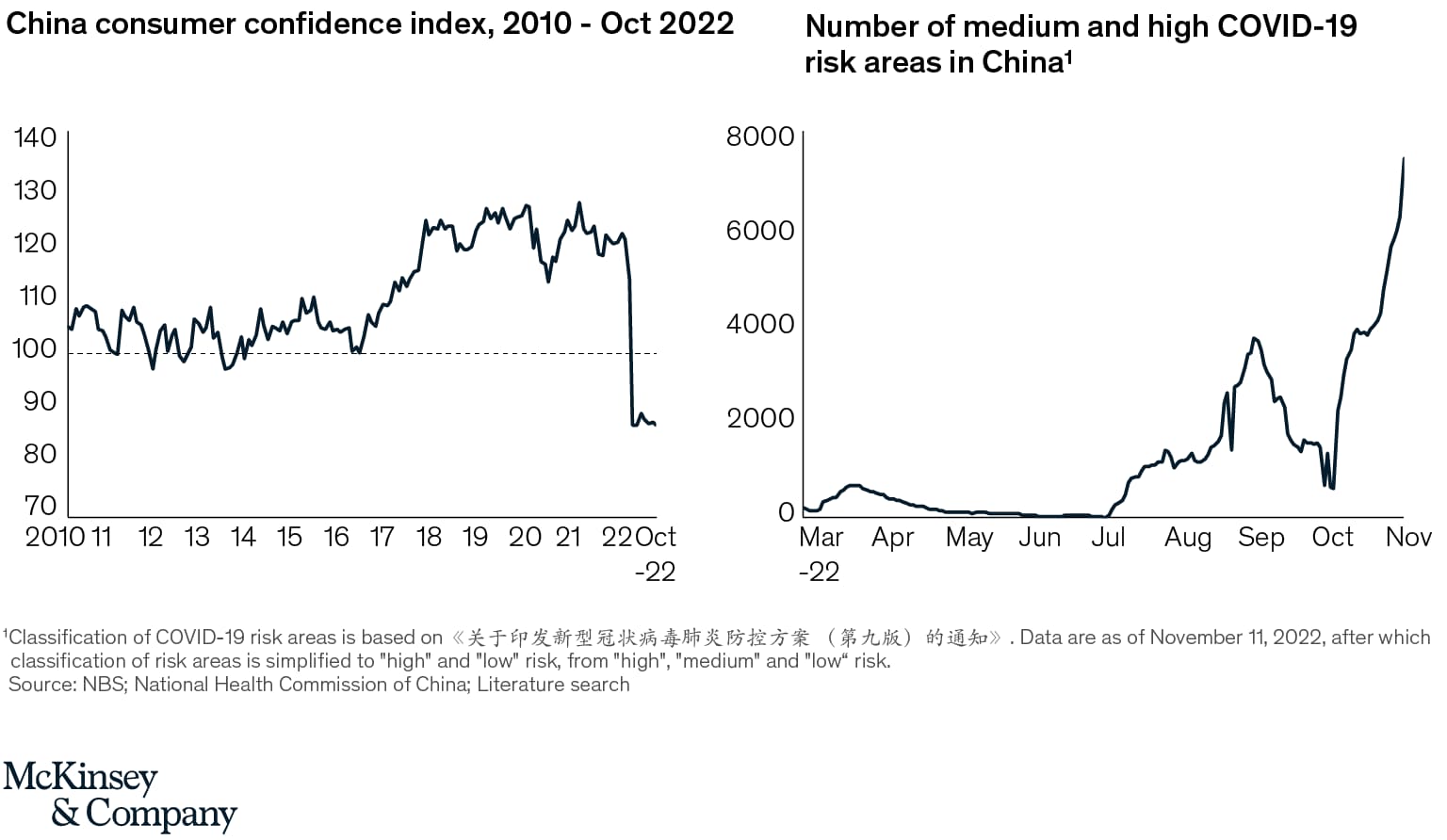Following years of heady economic growth and rising consumer spending, recent macroeconomic pressures have sapped Chinese consumer sentiment. Stock market sell-offs, declining property transactions, and mobility restrictions designed to slow the spread of COVID-19 clouded consumers’ outlook.
China’s consumer confidence index, a closely-watched number calculated by China’s National Bureau of Statistics (NBS), dropped below 90 in April, a record low (Exhibit 1).

Historically high savers, Chinese consumers in 2022 doubled-down on their intent to put their money in the bank rather than spend it. According to McKinsey’s latest nationwide survey of Chinese consumers, 58 percent of urban households indicated their desire to “put money away for a rainy day,” the highest level since 2014, and 9 percentage points higher than in our previous survey conducted in 2019. Chinese consumers’ increased propensity to save their money rather than spend it has been evident in the rapid growth in savings deposits, which swelled by RMB 14 trillion during the first 9 months of 2022 (Exhibit 2).

Despite these economic headwinds, and the decline in consumer confidence, China’s economy continues to exhibit a certain level of resilience. Nominal disposable income per capita rose by 5.3 percent in the first nine months of 2022, according to NBS statistics. Urban unemployment held steady at 5.5 percent in September, comparable to pre-pandemic levels, and consumer price inflation rose by just 2.0 percent in the first nine months of 2022.
And despite media reports of the impending downsizing or even withdrawal of multinational companies in China, inbound foreign direct investment (FDI) in China has been running at historical highs, having hit a record $181 billion in 2021, a 21 percent surge compared with the previous year, according to the Ministry of Commerce.
Despite downward pressure on economic growth, FDI again expanded rapidly in the first six months of 2022, rising 24 percent year-on-year.
Consumer companies in China are consequently scrutinizing their strategies. Will the economy—and consumer sentiment—get worse? Or will they improve? If, and when, consumers bounce back, they will certainly have a lot of money to spend.
To help shed light on these critical questions, we recently conducted an extensive analysis of the state of play of the Chinese consumer. In this report, we highlight five trends that are shaping consumer behavior.
Our analysis draws on an extensive nationwide survey of over 6,700 Chinese consumers conducted in July 2022, a separate “Pulse” survey of consumer attitudes in China and several other markets, online transaction data for more than 1,000 product categories across most major Chinese ecommerce platforms, and economic modeling conducted by the McKinsey Global Institute (MGI).
1. The middle-class continues to rise.
There is still no other country that adds as many households to the middle class each year as China does. And increasingly, these households are joining the ranks of the upper-middle and high-income bracket, with annual incomes above RMB160,000. Over the next three years, China is expected to add another 71 million upper-middle and high-income households.
2. Premiumization maintains momentum.
Even during challenging times, premium brands still outperform mass brands. Despite rising anxiety over the economy and their personal incomes, when they do spend, consumers still trade up to more premium brands when they’re looking to reward themselves. And with the introduction of trendy innovative local brands, many foreign brands that once enjoyed a leading position in the mass or mainstream segment are feeling the pressure, and have seen steep declines in sales.
3. Smarter choices, but not trading down.
Consumers are not trading down, but they are getting much smarter about what they buy and where. They are very creative at finding the cheapest way to buy the brand they want, whether it’s through WeChat groups, parallel imports on Taobao, or the latest livestreaming deal. Without compromising on the brand and product they desire, they are making more rigorous trade-off decisions and more actively seeking discounts and promotions. Some are even managing to consume more while spending less.
4. It’s all about the product.
Consumers are savvy and know how to educate themselves about the technical specifications of their favorite products on social media. They know the precise ingredients that go into their skincare routine, for example, or can compare and contrast the thermal efficacy and down content of their jackets.
5. Local companies are winning.
There once was a time when consumers paid a premium for foreign brands; those days are over. Chinese companies today offer excellent products that are competitive or sometimes even superior to their foreign peers. So, while it’s not a new phenomenon, the preference for local brands has accelerated in the past few years. And, contrary to what many think, national pride is not the only driving factor. Today, domestic companies are reacting faster to trends, are closer to the consumer, and are making bolder investments.
These five trends have important implications for consumer companies which we describe in this report. In our conclusion, we suggest four steps executives can take to ensure their consumer brands endure and prosper amid the volatility.
Click here to download the full report, “2023 McKinsey China Consumer Report: A Time of Resilience.